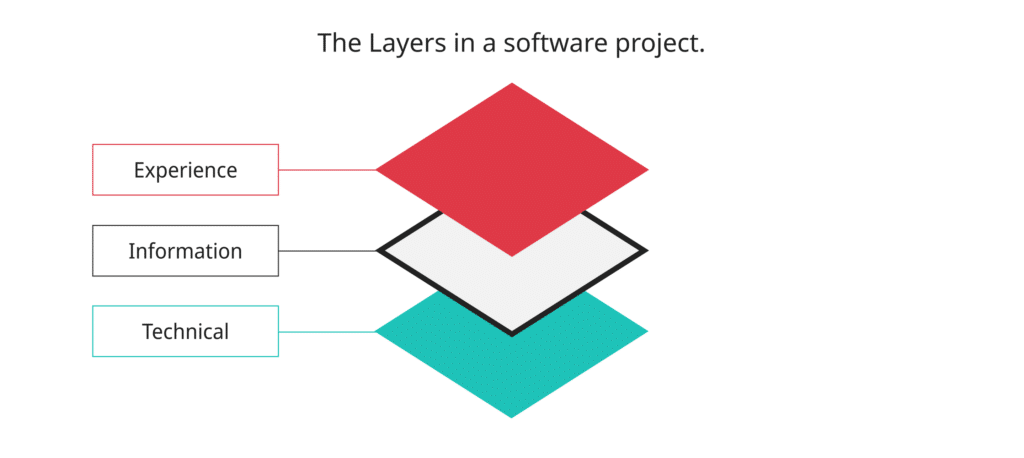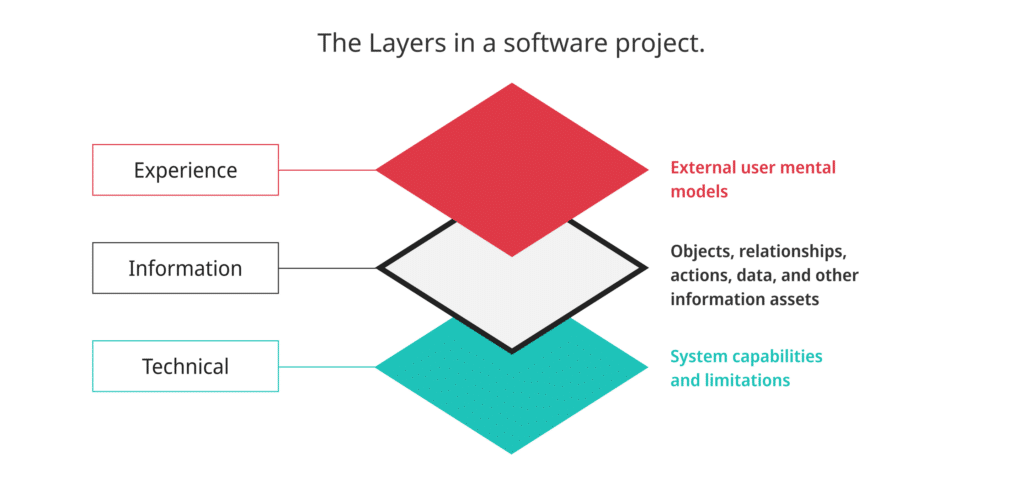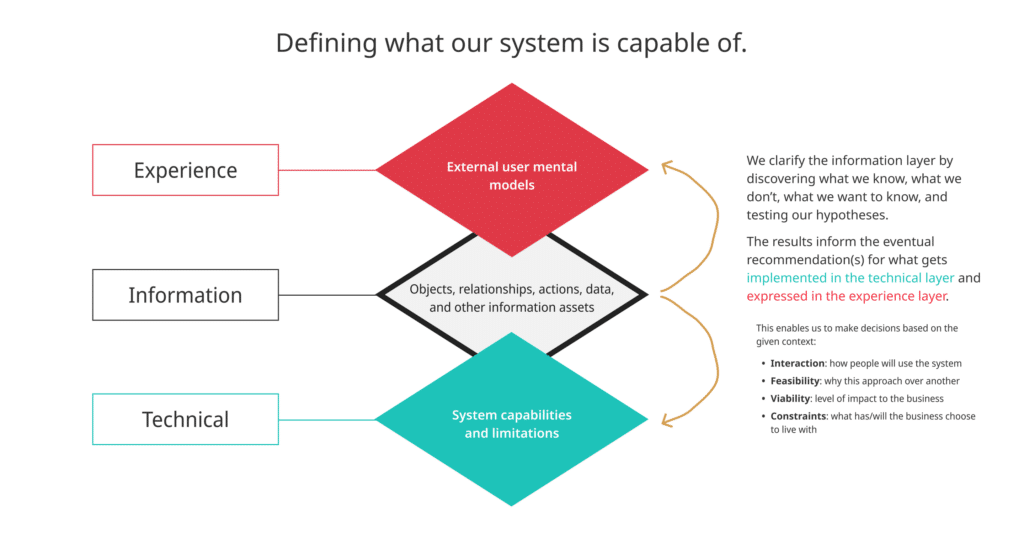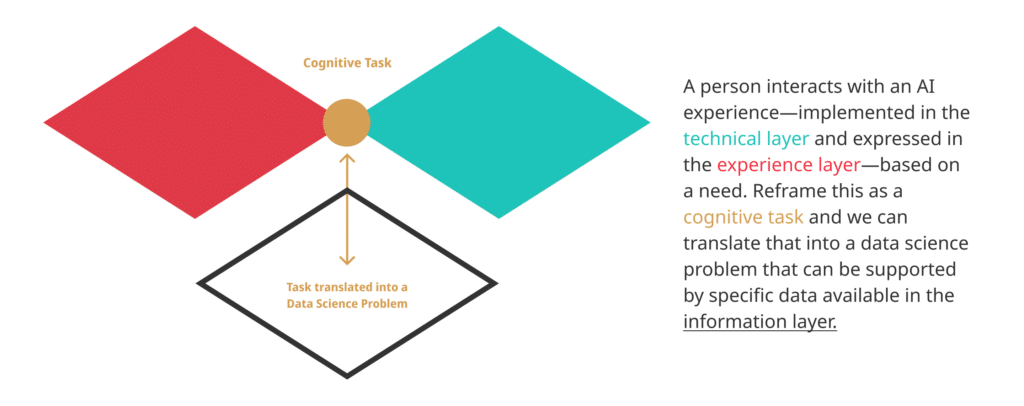Article summary
Valuable Artificial Intelligence (AI) experiences, ones actually designed for humans, don’t require a rethink of the way we design software. Instead, they require a reframing of the way we think about the information and how we use it to meet people’s needs. It’s also the only real opportunity in the space for innovation. AI innovation projects that skip human-centered problem definition can end up focused on the wrong problem. That can lead to solutions that aren’t valuable to end users, like, I dunno, creating a $700 AI pin that people don’t actually want to wear. I’ll argue that only a human-centered AI approach offers real opportunities for innovation.
Before we get into reframing how we think about the information in our software projects, I want to provide a brief explainer. Let’s look at the concepts that make up the foundation for these thoughts.
The Layers of a Software Project
Every enterprise, B2B, D2C, start-up, civic tech, or productivity tool project has three layers. The definition, documentation, and creation of these layers and how they impact each other is what defines a system and its capabilities. The system’s ability to label, organize, display, or anticipate, impacts the user’s ability to understand and use it. These attributes are enabled by the architecture of the information layer. They also define the true success/failure tipping point of any project.
 The Experience Layer – This is the layer that people will interact with. It’s the interface defined by the decisions made about how we will express the data in the information layer and what we will allow users to do to manipulate objects to meet their needs. This layer will need to inform and/or relate to the end user’s mental model to be effective.
The Experience Layer – This is the layer that people will interact with. It’s the interface defined by the decisions made about how we will express the data in the information layer and what we will allow users to do to manipulate objects to meet their needs. This layer will need to inform and/or relate to the end user’s mental model to be effective.
The Information Layer – This layer contains the decisions made about the objects, relationships, actions, data, and other information assets we want in our system. This information gets implemented in the technical layer and expressed in the experience layer. Defining this is how we define what our system will be capable of.
The Technical Layer – This is the layer that Includes the software decisions and processes used to manage the system. This is where integration happens and often where the data for analytics and measurement comes from. Decisions made here impact the system’s capabilities and impose constraints.

Defining What’s Possible
How we clarify the information layer impacts what gets implemented in the technical layer and expressed in the experience layer. Defining this is how we define what our system will be capable of.

Now that we’ve set the foundation for our discussion we’ll look at how we can reframe our thinking to understand how AI changes the way an AI interaction will interact with the information layer.
Accomodating AI Interactions
How AI interactions change the way we clarify and interact with the information layer.
The layers of our software project don’t change an ML, AI, LLM, GenAI, or Agentic AI system. What changes is the relationship between the layers and how we’ll use them. Specifically, we need to reframe our perspective from a traditional task-based interaction to a cognitive task-based interaction.
I came across this concept when I read the research article Cognitive Strategy Prompts: Creativity Triggers for Human Centered AI Opportunity Detection, (Authors: Johannes Schleith, Milda Norkute, Mary Mikhail, Daniella Tsar). It speaks to the idea that “Creative problem solving and innovation powered by Artificial Intelligence (AI) requires detection of user needs that can be reframed into data science problems.” It’s a fascinating and practical look at the concepts and process for identifying AI opportunities and goes much deeper than I will here.
Defining a Standard Software Interaction
A standard software interaction is when a person performs a task at the intersection of the three layers. The defined information has been expressed in the experience layer via a UI. It’s also supported by the underlying technology that enables it to run and perform actions. The user has a need, often framed as a job-to-be-done task, that they are using the software to solve. The overlap of the three layers is how this task is supported.

Reframing to Identify AI Opportunities
With AI interactions, the information is no longer expressed in the experience layer. We’ve clarified it in the information layer. However, the constraints imposed by the technical layer (the AI solution) mean the user interacts directly with the technology to access the information layer to solve for a need. To account for this, and identify the ways our proposed AI solution will be valuable, we need to think about the interaction through the lens of data science problems. In their paper, the authors propose reframing the job-to-de-done task as a cognitive task or activity that AI technology can support.

Defining Data Science Problems
Data science is what powers AI so the idea is to identify a way to communicate user needs to specific data science problems. This really just means mapping what the user is trying to do and translating that into the ways data science methods would find relevant data to meet that user need.
Here’s an example:
User’s cognitive task:
- Compare or find the relationship between different information
Data Science Problems:
- Relationship extraction
- Relationship classification
- Knowledge graphs
- Clustering
In this way, the team would then be able to create hypotheses. Then, they can run experiments to understand how well/poorly the current solution is set up to meet user’s needs. In essence, they’d be using the same research, experimentation, and prototyping approach employed during more traditional software projects.
Don’t assume every problem is worth solving with AI.
The key takeaway from this research article is that we don’t need to change how we build software fundamentally to integrate AI solutions. As with any new technology, we must look critically at what it does well and how to use it to solve problems people already have. AI may seem like a revolutionary software. But, as we’ve seen, much of its current implementation has floundered by trying to find problems to solve after implementing it. And, we know that doesn’t work.
Imagine buying a lawn mower before you even know if you have grass to mow? It might seem like a simplistic metaphor but it also feels apt given the current state of adding AI to all the things.

